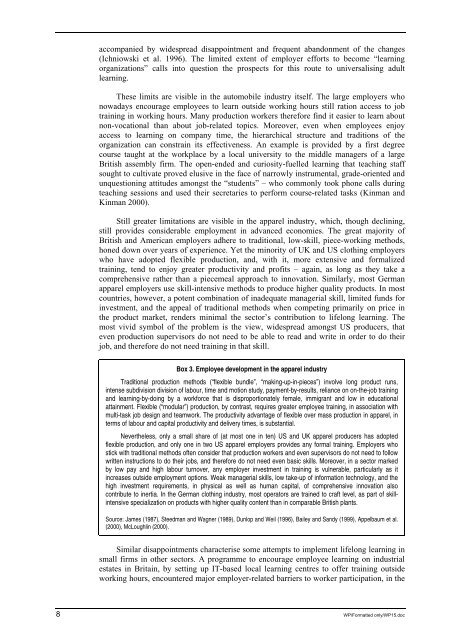Lifelong learning - International Labour Organization
Lifelong learning - International Labour Organization
Lifelong learning - International Labour Organization
Create successful ePaper yourself
Turn your PDF publications into a flip-book with our unique Google optimized e-Paper software.
accompanied by widespread disappointment and frequent abandonment of the changes<br />
(Ichniowski et al. 1996). The limited extent of employer efforts to become “<strong>learning</strong><br />
organizations” calls into question the prospects for this route to universalising adult<br />
<strong>learning</strong>.<br />
These limits are visible in the automobile industry itself. The large employers who<br />
nowadays encourage employees to learn outside working hours still ration access to job<br />
training in working hours. Many production workers therefore find it easier to learn about<br />
non-vocational than about job-related topics. Moreover, even when employees enjoy<br />
access to <strong>learning</strong> on company time, the hierarchical structure and traditions of the<br />
organization can constrain its effectiveness. An example is provided by a first degree<br />
course taught at the workplace by a local university to the middle managers of a large<br />
British assembly firm. The open-ended and curiosity-fuelled <strong>learning</strong> that teaching staff<br />
sought to cultivate proved elusive in the face of narrowly instrumental, grade-oriented and<br />
unquestioning attitudes amongst the “students” – who commonly took phone calls during<br />
teaching sessions and used their secretaries to perform course-related tasks (Kinman and<br />
Kinman 2000).<br />
Still greater limitations are visible in the apparel industry, which, though declining,<br />
still provides considerable employment in advanced economies. The great majority of<br />
British and American employers adhere to traditional, low-skill, piece-working methods,<br />
honed down over years of experience. Yet the minority of UK and US clothing employers<br />
who have adopted flexible production, and, with it, more extensive and formalized<br />
training, tend to enjoy greater productivity and profits – again, as long as they take a<br />
comprehensive rather than a piecemeal approach to innovation. Similarly, most German<br />
apparel employers use skill-intensive methods to produce higher quality products. In most<br />
countries, however, a potent combination of inadequate managerial skill, limited funds for<br />
investment, and the appeal of traditional methods when competing primarily on price in<br />
the product market, renders minimal the sector’s contribution to lifelong <strong>learning</strong>. The<br />
most vivid symbol of the problem is the view, widespread amongst US producers, that<br />
even production supervisors do not need to be able to read and write in order to do their<br />
job, and therefore do not need training in that skill.<br />
Box 3. Employee development in the apparel industry<br />
Traditional production methods (“flexible bundle”, “making-up-in-pieces”) involve long product runs,<br />
intense subdivision division of labour, time and motion study, payment-by-results, reliance on on-the-job training<br />
and <strong>learning</strong>-by-doing by a workforce that is disproportionately female, immigrant and low in educational<br />
attainment. Flexible (“modular”) production, by contrast, requires greater employee training, in association with<br />
multi-task job design and teamwork. The productivity advantage of flexible over mass production in apparel, in<br />
terms of labour and capital productivity and delivery times, is substantial.<br />
Nevertheless, only a small share of (at most one in ten) US and UK apparel producers has adopted<br />
flexible production, and only one in two US apparel employers provides any formal training. Employers who<br />
stick with traditional methods often consider that production workers and even supervisors do not need to follow<br />
written instructions to do their jobs, and therefore do not need even basic skills. Moreover, in a sector marked<br />
by low pay and high labour turnover, any employer investment in training is vulnerable, particularly as it<br />
increases outside employment options. Weak managerial skills, low take-up of information technology, and the<br />
high investment requirements, in physical as well as human capital, of comprehensive innovation also<br />
contribute to inertia. In the German clothing industry, most operators are trained to craft level, as part of skillintensive<br />
specialization on products with higher quality content than in comparable British plants.<br />
Source: James (1987), Steedman and Wagner (1989), Dunlop and Weil (1996), Bailey and Sandy (1999), Appelbaum et al.<br />
(2000), McLoughlin (2000).<br />
Similar disappointments characterise some attempts to implement lifelong <strong>learning</strong> in<br />
small firms in other sectors. A programme to encourage employee <strong>learning</strong> on industrial<br />
estates in Britain, by setting up IT-based local <strong>learning</strong> centres to offer training outside<br />
working hours, encountered major employer-related barriers to worker participation, in the<br />
8 WP/Formatted only/WP15.doc

















